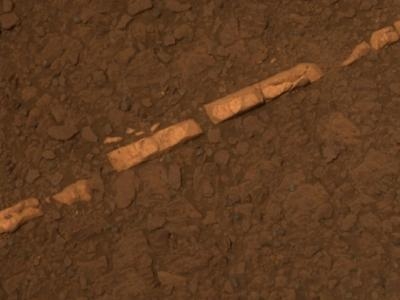Project Leader Calls Finding A 'Slam Dunk' Proving A Once-Wet
Martian Environment
NASA's Mars Exploration Rover Opportunity has found bright veins
of a mineral, apparently gypsum, deposited by water. Analysis of
the vein will help improve understanding of the history of wet
environments on Mars. "This tells a slam-dunk story that water
flowed through underground fractures in the rock," said Steve
Squyres of Cornell University, principal investigator for
Opportunity. "This stuff is a fairly pure chemical deposit that
formed in place right where we see it. That can't be said for other
gypsum seen on Mars or for other water-related minerals Opportunity
has found. It's not uncommon on Earth, but on Mars, it's the kind
of thing that makes geologists jump out of their chairs."
Gypsum Is Bright White Material
Center

The latest findings by Opportunity were presented Wednesday at
the American Geophysical Union's conference in San Francisco. The
vein examined most closely by Opportunity is about the width of a
human thumb (0.4 to 0.8 inch), 16 to 20 inches long, and protrudes
slightly higher than the bedrock on either side of it. Observations
by the durable rover reveal this vein and others like it within an
apron surrounding a segment of the rim of Endeavour Crater. None
like it were seen in the 20 miles (33 kilometers) of crater-pocked
plains that Opportunity explored for 90 months before it reached
Endeavour, nor in the higher ground of the rim.
Last month, researchers used the Microscopic Imager and Alpha
Particle X-ray Spectrometer on the rover's arm and multiple filters
of the Panoramic Camera on the rover's mast to examine the vein,
which is informally named "Homestake." The spectrometer identified
plentiful calcium and sulfur, in a ratio pointing to relatively
pure calcium sulfate.
Calcium sulfate can exist in many forms, varying by how much
water is bound into the minerals' crystalline structure. The
multi-filter data from the camera suggest gypsum, a hydrated
calcium sulfate. On Earth, gypsum is used for making drywall and
plaster of Paris. Observations from orbit have detected gypsum on
Mars previously. A dune field of windblown gypsum on far northern
Mars resembles the glistening gypsum dunes in White Sands National
Monument in New Mexico. "It is a mystery where the gypsum sand on
northern Mars comes from," said Opportunity science-team member
Benton Clark of the Space Science Institute in Boulder, Colo. "At
Homestake, we see the mineral right where it formed. It will be
important to see if there are deposits like this in other areas of
Mars."
Homestake Deposit

The Homestake deposit, whether gypsum or another form of calcium
sulfate, likely formed from water dissolving calcium out of
volcanic rocks. The minerals combined with sulfur either leached
from the rocks or introduced as volcanic gas, and was deposited as
calcium sulfate into an underground fracture that later became
exposed at the surface.
Throughout Opportunity's long traverse across Mars' Meridiani
plain, the rover has driven over bedrock composed of magnesium,
iron and calcium sulfate minerals that also indicate a wet
environment billions of years ago. The highly concentrated calcium
sulfate at Homestake could have been produced in conditions more
neutral than the harshly acidic conditions indicated by the other
sulfate deposits observed by Opportunity. "It could have formed in
a different type of water environment, one more hospitable for a
larger variety of living organisms," Clark said.
Homestake and similar-looking veins appear in a zone where the
sulfate-rich sedimentary bedrock of the plains meets older,
volcanic bedrock exposed at the rim of Endeavour. That location may
offer a clue about their origin. "We want to understand why these
veins are in the apron but not out on the plains," said the
mission's deputy principal investigator, Ray Arvidson, of
Washington University in St. Louis. "The answer may be that rising
groundwater coming from the ancient crust moved through material
adjacent to Cape York and deposited gypsum, because this material
would be relatively insoluble compared with either magnesium or
iron sulfates."
Opportunity and its rover twin, Spirit, completed their three-month
prime missions on Mars in April 2004. Both rovers continued for
years of extended missions and made important discoveries about wet
environments on ancient Mars that may have been favorable for
supporting microbial life. Spirit stopped communicating in 2010.
Opportunity continues exploring, currently heading to a sun-facing
slope on the northern end of the Endeavour rim fragment called
"Cape York" to keep its solar panels at a favorable angle during
the mission's fifth Martian winter. (Images courtesy NASA)
 ANN's Daily Aero-Linx (04.15.24)
ANN's Daily Aero-Linx (04.15.24) Classic Aero-TV: 'No Other Options' -- The Israeli Air Force's Danny Shapira
Classic Aero-TV: 'No Other Options' -- The Israeli Air Force's Danny Shapira Aero-News: Quote of the Day (04.15.24)
Aero-News: Quote of the Day (04.15.24) Airborne 04.16.24: RV Update, Affordable Flying Expo, Diamond Lil
Airborne 04.16.24: RV Update, Affordable Flying Expo, Diamond Lil ANN's Daily Aero-Term (04.16.24): Chart Supplement US
ANN's Daily Aero-Term (04.16.24): Chart Supplement US




